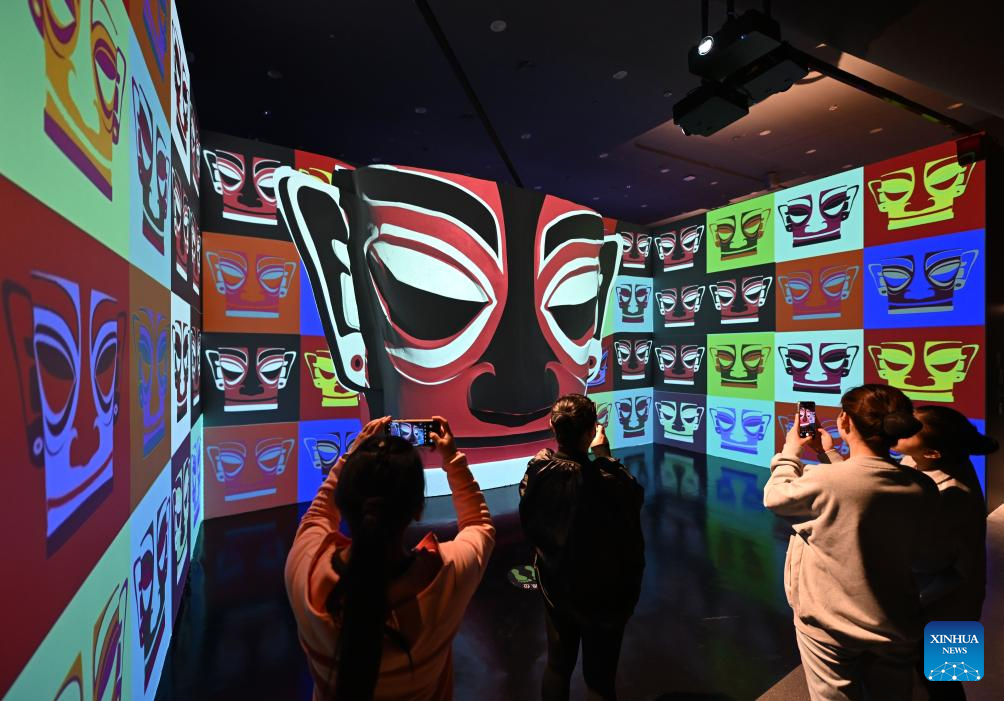
By enlivening intangible cultural heritages and recreating digital scenic spots, Sichuan province is using a "culture-plus-technology" model to showcase its cultural soft power, enabling 63.72 million trips during the Spring Festival holiday that generated 34.78 billion yuan ($4.8 billion) in revenue.
Sichuan's efforts to bring cultural relics to life have won widespread praise. The provincial authorities have used artificial intelligence in the digital exhibition hall of the Sanxingdui Museum to help a Shang Dynasty bronze tree to shine in "divine brilliance", and 3D holographic projection to reproduce ancient ritual scenes. These digital creations have helped the museum to attract 3.23 million tours, marking a three-fold growth.
Decoding cultural relics using digital means also creates surprises. Digital collections, themed "the fairyland of ancient Sichuan"-known as Shu in ancient times as it was home to the ancient Shu civilization — are selling like hot cakes by integrating the bronze mask with elements such as the giant panda and the face-changing performances of Sichuan Opera.
READ MORE: Museums open window for cultural exchanges
At the 2025 Spring Festival Gala hosted by the China Media Group, Li Ziqi, a social media influencer known for promoting Chinese culture, made a stunning debut in a look that incorporated 13 elements of China's intangible cultural heritage. Her appearance vividly showcased the creative potential of presenting traditional culture through modern design and media.
Technology has also helped rebuild scenic spots, giving visitors an experience in "time-travelling" and generating substantial tourism revenue. For instance, during the Spring Festival holiday, the night tour on the Jinjiang River, themed "Vibrant Year in Chengdu, New Vibes of Jinjiang River", welcomed 466,300 visits.
Besides, the digital scroll has brought ancient scenes to life through 5G and 8K technologies. Fifty themed boats cruise along the banks of the Jinjiang River in the 3D projection, representing the historical scenes of greeting the cruise boats.
The Mount Qingcheng-Dujiangyan scenic spot, on its part, has developed a digital experience center dedicated to immersive exploration of Taoist culture by using mixed reality technology to reproduce the scene when Zhang Daoling founded Taoism. The scene of visitors receiving "digital blessings", projected through motion-sensing interaction, is complemented by a series of themed events including "encounter with Erlang Shen". The innovative charm of this technology-powered immersive cultural experience attracted an impressive 594,800 visits during Spring Festival.
As an effective means to modernize traditional villages, digital technology supports rural vitalization. The newly built Qiang culture digital museum in Sichuan's Aba (Ngawa) Tibetan and Qiang autonomous prefecture has recreated the ancient Qiang watchtower construction technique using 3D modeling, which visitors can experience through visual reality in the Qiang embroidery workshop.
In Lizhuang ancient town, known as the "most admirable ancient town on the Yangtze River", a brand-new academia-culture-tourism complex has been built on the former site of the Society for Research in Chinese Architecture. The structure in Sichuan's Yibin city, which is part of a holistic layout of "one hall, one heritage site, one pond, one street, and 24 courtyards", recreates, via a digital sandbox, the scenes of Liang Sicheng, known as the "father of modern Chinese architecture", surveying and mapping ancient architecture.
This innovative model, combining academic features with digital twin technology, showcases the evolution of traditional architectural craftsmanship in a modern context, transforming historical memories into contemporary experiences.
A systemic upgrade of the industry ecosystem is also underway. The transformation of Dongjiao Jiyi, which means an eastern suburban memory park, is a benchmark. Repurposed from a former State-owned electronics tube factory, the site has been developed into a cultural complex, which today is home to nearly 300 cultural-tech enterprises. It has established a full industry chain encompassing brand incubation, digital technology empowerment and scene renewal.
ALSO READ: Future of tourism human-centered
The development of transportation in Sichuan, too, is boosting tourism, with tourism highways making journeys more memorable. Three highways have been selected in the first batch of the national "tourism highway project". Of particular significance is the completion of the grand loop in western Sichuan, a highway network that connects Chengdu, Ya'an, the Ganzi Tibetan autonomous prefecture and the Aba Tibetan and Qiang autonomous prefecture, as well as the iconic scenic areas of Jiuzhaigou and Daocheng Yading. This network has made the vision of "swift arrival, immersive travel" a reality.
With the application of advanced digital technology, the once difficult roads of Shu have been turned into smooth culture-tourism highways. Sichuan is exploring the deeper logic of culture-tourism integration to not only breathe new life into the cultural heritage of ancient Shu in the digital age, but also offer dynamic Sichuan experience to visitors through systemic industry restructuring.
In Sichuan, every landscape carries the weight of cultural history, and every practice of innovation adds a new story to the region's legacy of brilliance.
Yin Yunqiang is a professor at the School of Management and Economics, University of Electronic Science and Technology of China.
Wang Dujuan is a professor at the Business School, Sichuan University.
The views don't necessarily reflect those of China Daily.


